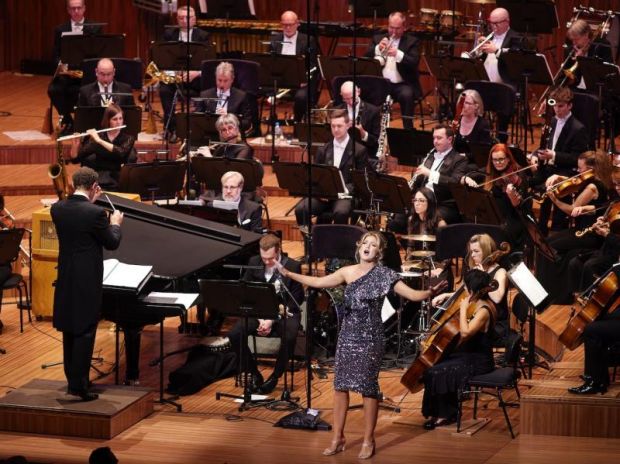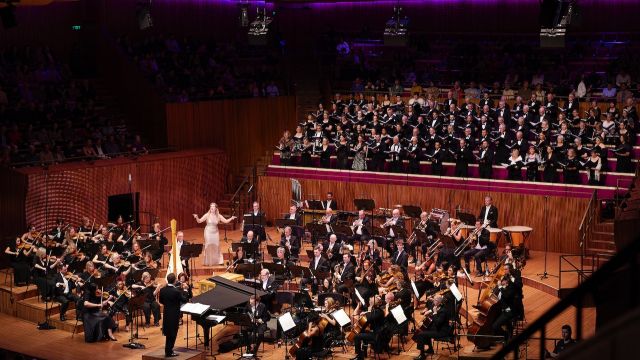The Golden Age of Broadway
Mind blowing in every sense! The music, the singing, the imagination, the acting … a total ‘wow’!
This was a concert conceived to captivate! Broadway Hits from the 1940s, 50s and 60s. From shows that helped the world recover from a nasty war. Shows that were transferred from the stage to the silver screen then to television sets in living rooms all over the world. Shows with big orchestras, optimistic stories, wonderful songs … songs that were played again and again from treasured record albums.
Making this concert part of the 50th birthday celebrations was an inspiration. Broadcasting it to the forecourt of “The House” spread the joy even further. The atmosphere outside on the steps was fizzing well over an hour before the performance began – and inside the very full Concert Hall the atmosphere was electric as Brett Weymark and his magic baton took the stage. And the elation grew!

Weymark and the orchestra, choir and soloists took the audience on a joyous journey around the world. It crossed America from Broadway to Oklahoma, sailed to “an island, looking on an ocean” in the South Pacific, then flew north to a kingdom in Siam and across Europe to London and Royal Ascot.
The journey thoughtfully reflected the hopes and concerns of a new post-war era – and the songs were carefully programmed to link themes and tempos. The theme of new beginnings was linked by “Blue Skies” from White Christmas and Nellie Forbush’s “Cockeyed Optimist” from South Pacific. The moon shone on different situations – and in different tempos – in “What Good Would the Moon Be?” from Street Scene, “The Man in the Moon” from Mame and “Moonshine Lullaby” from Annie Get Your Gun.

The orchestra had its own very special moments, especially with the allusively evocative strains of the waltz from Carousel. The Choirs, resplendently theatrical in black and white and some cunningly subtle bling and feathers, gave a very British rendition of the “Ascot Gavotte” from My Fair Lady.
Memories of those wonderful shows are often associated with the actors who performed them. Rightly so, because it was their interpretation of the characters and the songs that made them so memorable. But good performers don’t need elaborate sets and costumes to be memorable.
Certainly not performers like Virginia Gay, Georgina Hopson, Kanen Breen and Alexander Lewis. The performances they gave last night were just stunning! All four have magnificent voices, all have a wealth of experience in all areas of musical theatre – all can create the character behind the lyrics and the mood of the music wherever they are performing.

Last night, in the Concert Hall, and outside on the big screen in the forecourt, they did just that!
Kanen Breen became a very persuasive, priestly Nicely-Nicely Johnson from as he sang “Sit Down You’re Rockin’ the Boat” – and an agile Jed Potter from Blue Skies as he put on “The Ritz”. Perhaps he wasn’t “dressed up like a million-dollar trooper” but his jacket sparkled just as brilliantly as his voice.
Virginia Gay has an eclectic theatre background and compelling stage presence. Her performance last night was a crowd pleaser, whether playing the trombone with the orchestra, becoming Hattie Walker singing “Broadway Baby” from Follies or a “Bewitched, Bothered and Bewildered” Vera Simpson from Pal Joey.

Georgina Hopson is similarly talented and charismatic! She captivated as both the English governess Anna Leonowens wondering “Shall We Dance” from The King and I and the metamorphosed Eliza Doolittle telling Mrs Higgins she “Could have Danced All Night”.
The wonderful tenor Alexander Lewis returned to the Concert Hall with the SPC, after his performance in Handel’s Samson. But in this performance he was much less sombre, his actions much less restricted! With the Choirs he explained that “A Secretary is not a Toy” and with Kanen Breen sang the stirring “Brotherhood of Man” and “New York, New York” from On the Town.
The four joined together in the choruses of many of the songs, and in the rousing theme song from Oklahoma! that led, resoundingly into the interval. Gay led them into the much-loved “Hello, Dolly” which closed the show to a standing ovation that, eventually and noisily, dragged them back for a short reprise.

Shows such as these are hard to put together. Just the choice of which shows and what songs takes judicious thought. Which will best show off the choir and the orchestra? Which best suit the soloists? How should the program be arranged?
With Weymark at the helm and the incredible Sydney Philharmonia’s musical directors and administrative staff, behind him, those decisions were made surely and successfully. This special concert is an example of a special musical event that will be as shine as memorably as the Broadway musicals on which it was based.
Carol Wimmer
Photographers: Keith Saunders and Simon Crossley-Meates
Subscribe to our E-Newsletter, buy our latest print edition or find a Performing Arts book at Book Nook.

